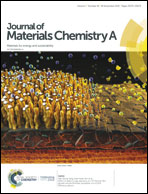Highly accessible hierarchical porous carbon from a bi-functional ionic liquid bulky gel: high-performance electrochemical double layer capacitors†
Abstract
The π–π interactions between graphene-based lamellar materials hinder their application in high-energy-density electrochemical double-layer capacitors (EDLCs) due to the limited surface area and mismatched pore size with ionic liquid electrolytes. Ionic liquid-graphene bulky gels work well in inhibiting the aggregation of graphene layers. Herein, we report an in situ one-pot process involving the carbonizing of an ionic liquid-based bulky gel to realize an unstacked 2D nanosheet structure and hierarchical porous design. The bulky gel formed by the ionic liquid ensures the stabilization of the laminated structure and regulates the size of the pores in situ. The facile process ensures that the as-synthesized 2D graphene-based porous carbon (GGI) possesses high surface area, dual-doping and micro/mesopores. The highly accessible GGI exhibited good compatibility with the ionic liquid electrolyte EmimTFSI. The constructed symmetric supercapacitors showed a high capacitance of 301 F g−1 at 0.5 A g−1, an excellent rate capability (maintained 192 F g−1 at 10 A g−1) and long cycle life (91.4% performance retention after 10 000 cycles). The high energy density of 100.3 W h kg−1 indicates the successful construction of the EDLC devices.



 Please wait while we load your content...
Please wait while we load your content...